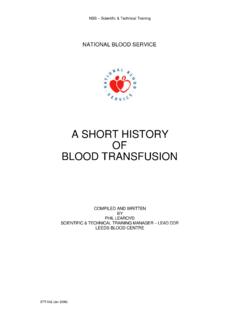Transcription of The DCS Story - Nikon and Kodak DSLR history
1 The DCS Story 17 years of Kodak Professional digital camera systems 1987-2004 Jim McGarvey June 2004 Electro-Optic Camera (1988) By 1987, Kodak had developed the world's first megapixel CCD imager, the M1. A US Government customer contracted with the Federal Systems Division (FSD) to incorporate the M1 into a standard 35 mm camera body to create the first megapixel portable digital camera, truly the prototype of the digital camera system (DCS) product line. It was designed for covert use, with the black box in a camera bag and the ribbon cable to the camera body concealed inside the neck strap. Images were downloaded from the internal hard drive by docking the black box on an Exabyte tape archive unit. (The first digital camera dock!) The Canon F1 film camera body had no electronic interface, so the shutter release was detected by monitoring the battery current.
2 The imager package was mounted to a TE cooler to reduce noise, but cooling was limited to prevent fogging the cover glass and was not very effective. Only one unit was built. The black box electronics were wire wrapped. Stock Canon F1 body with motor drive Monochrome KAF-1400 (M1) imager (1320 x 1035, m) with thermoelectric cooler 10bit A/D Logarithmic amplifier 10-Mbyte buffer for 6-image burst; buffer image count display Internal 100-Mbyte SCSI hard drive holds 60 images; disk image count display Docking archive unit with 2000-MByte Exabyte 8 mm SCSI tape drive and battery charger Raw image files in Unix TAR format; Time/Date stamp Intervalometer; log histogram. Pixel value readout. Image delete. Image recover; disk erase; disk format Alphanumeric LCD with menus, status, and error messages Three-color LED disk, buffer, battery status indicators on camera back Intel 80C196 uController, PL/M Internal lead acid camcorder battery Tactical Camera (1989) When FSD marketing saw the electro-opitcal (EO) camera, they saw an opportunity to create digital cameras for the military.
3 Based on the EO camera design, the Tactical camera was made more rugged by eliminating the internal hard drive and using the buffer memory to store images until they could be unloaded to external SCSI storage. With a motor drive, the camera would capture a "movie" at 5 fps and play it back just as fast from memory. Two demo units were built and demonstrated to many government customers. Selectable 1280 x 1024 or 640 x 512 resolution 20-Mbyte buffer for 12/48 image burst at 5 fps RS-170 NTSC video output with superimposed image data Zoom and pan high res image All other features of EO camera, except TE cooler, hard drive, archive unit HAWKEYE II Imaging Accessory (1989) Demonstrations of the Tactical camera generated a lot of interest, but its size and weight precluded military field use. FSD borrowed the mechanical design of the PPD IRIS camera, developed a DRAM image storage module (ISM) with more capacity than the available memory cards, and created a compact camera design with real printed circuit boards.
4 Exotic and expensive lithium batteries kept the power-hungry camera and ISM going. The name imaging accessory was used because Kodak was reluctant to develop digital cameras that might compete with film. Five units were built. Stock Nikon F3 body Selectable 1280x1024 or 640x512 resolution 8-bit A/D Removable 5-Mbyte DRAM Image Storage Module for 4/16 images Replaceable lithium batteries All other features of Tactical camera, except motor drive HAWKEYE II Imaging Accessory (1989) The normal customer response to a demo of integrated Hawkeye II camera was, "That's incredible! It would be perfect for my application if it only had one more special feature." So FSD returned to the tethered camera configuration, designing a totally modular camera system that could be easily expanded and adapted.
5 A patented "image bus" backplane accommodated plug-in circuit boards. Interchangeable camera heads, battery and power modules completed the system. A few units were sold with Brier 20-Mbyte floppy drives and built-on video monitors. A two-headed camera was built for stereo photography. The camera achieved real fame in 1991, when it went into orbit on Shuttle mission STS-44. Stock Nikon F3 body, some units with motor winder Optional monochrome or color Kodak KAF-1300 series image sensor (M3) (1320 x 1035, 16 m) Internal 100-Mbyte hard drive Removable lead acid battery module Intel 80C188 uController, PL/M All other features of integrated Hawkeye II camera Camera Imager Pixels CFA ISO FPS Depth EO M1 1035x1320 Mono 200-800 5 6 Tactical M1 1024x1280 Mono 200-800 5 12 Hawkeye II int M1 1024x1280 Mono 50-400 0 4 Hawkeye II teth M1 1024x1280 Mono 50-400 2 6 Hawkeye II teth M3 1024x1280 Mono 50-400 2 6 Hawkeye II teth M3 1024x1280 3G RGB 50-400 2 6 D-5000 (1989) Developed by the Electronic Photography Division (EPD)
6 , The D-5000, or ECAM was the prototype of all modern professional digital single-lens reflex (SLR) cameras. A compact autofocus SLR with megapixel color imager, memory card slots, JPEG, and what's this? No image display on the back? The DOS model added a PCMCIA-ATA card slot. Although not a product of the FSD or Professional Photography Division (PPD) teams, the camera was marketed by FSD to government customers, and many of the original ECAM team brought their expertise to PPD for later projects. Color or monochrome Kodak KAF-1300 series image sensor (3M) (1280x1024, 16 m). Color ISO 160 Standard K mount lenses Auto focus with illuminator M, Av, Program auto exposure TTL flash Selectable color balance SRAM or flash memory card slot IRIS (1990) Larry McMillan of the Professional Photography Division (PPD) had championed the Kodak 35 mm rapid film scanner (RFS) to meet the news photographer's need to send images home electronically as quickly as possible.
7 He saw that a digital camera could eliminate the time to process film. IRIS was a confidential project to create a memory card camera for photojournalists. The camera was as simple as possible, with no image processing or bells and whistles; it saved the raw imager data to the card. Just a few demo units were built. Stock Nikon F3 body SRAM memory card slot Professional Camera Back (1990) Just as the integrated Hawkeye II camera was cool but not quite enough for the government customers, IRIS didn't meet the real needs of the news shooters. PPD had paid to develop the first color megapixel imager (M3) and conceived a fast frame rate news camera that could directly transmit images from the field without a computer. PPD had the right imager and the right market; FSD had the camera architecture, so the two teams combined the M3 with the Hawkeye II image bus electronics in a sleek and commercial-looking plastic housing.
8 Several demo cameras were shown privately at Photokina and publicly at the NPPA Electronic Workshop in November of 1990. Most of the FSD development team moved to PPD to commercialize a camera in response to the ensuing excitement. Kodak PROFESSIONAL DCS (1991) By May of 1991, PPD was ready to announce the first Kodak Professional Digital Camera System at a New York City press conference. The prototype camera was spruced up with a much larger image LCD and optional JPEG compression and serial transmission boards. Six models were priced from $20,000 to $25,000. The slogan "Convert to a new digital system without switching cameras" suggested that the familiar F3 camera body would make the digital transition simple and easy! To make the system easily luggable for the planet-roving photojournalist, a custom nylon hip pack and an enormous hard case were thrown in for free.
9 After the launch of the Kodak Professional DCS 200 IR digital camera, a magazine reviewer named this camera the DCS 100. Although never official, the name stuck, even within Kodak . A total of 987 units were sold from 1991 to 1994. Stock Nikon F3 body with motor winder Color or monochrome KAF-1300 (M3) imager (1320x1035, 16 m) 8-bit A/D Monochrome LCD image display NTSC video output SCSI interface Removable lead acid camcorder battery Intel 80C188 uController, PL/M multitasking firmware Internal 200-Mbyte hard drive (160 uncompressed/600 compressed images) Optional JPEG compression board, serial interface, and captioning keyboard 8- or 32-Mbyte buffer memory Acquire module software for Adobe Photoshop (Macintosh) Plug-in software for Aldus Photostyler (Windows) Camera Imager Pixels CFA ISO FPS Depth DCS DC3 M3 1024x1280 3G RGB 100-800 6 DCS DC3/32 M3 1024x1280 3G RGB 100-800 24 DCS DC3/B M3 1024x1280 3G RGB 100-800 6 DCS DM3 M3 1024x1280 Mono 200-1600 6 DCS DM3/32 M3 1024x1280 Mono 200-1600 24 DCS DM3/B M3 1024x1280 Mono 200-1600 6 Kodak PROFESSIONAL DCS 200 (1992) Announced at MacWorld Boston in August 1992, the DCS 200 targeted desktop publishing rather than photojournalism.
10 In sharp contrast to the complexity and cost of the original DCS, the 200 was the simplest DCS camera ever. Everything but the imager fit onto one circuit board. hard drives had just appeared and were just the size to tuck under the camera body. The 8008s was the least-expensive Nikon body with a removable back. The simple camera was conceived and commercialized in less than a year and shocked a market expecting minor improvements to the original DCS. The non-i models omitted the internal hard drive to lower the price. All models supported HitchHiker external hard drives for removable storage. For the commercial studio, a monochrome 200 with the Kodak Professional color filter wheel accessory produced superb color images. The filter wheel was an afterthought and was controlled by an interface piggybacked on the SCSI port.







